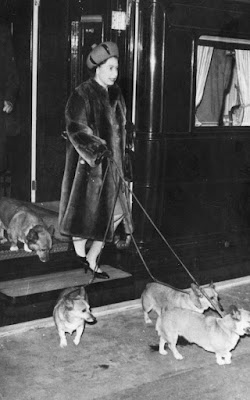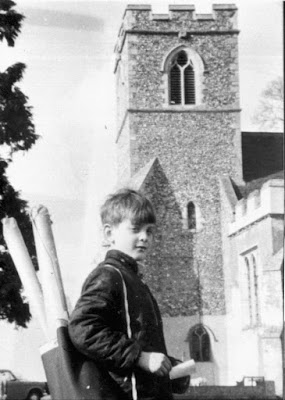The Windsor encounters, Dead and Alive
They say
even a cat can look at a queen. Well, we were not cats but we did have a chance
to look at a queen. It was in the winter of 1968. Barbara, the children and I
were on our way to visit relatives in Ipswich, an old Roman city 80 miles east
of London, and were waiting for our train at the Liverpool Street station in
London. There was a delay as we stood on the platform. A very fancy train
pulled slowly in, velvet barrier ropes were put in place, and Elizabeth, dogs
and kids stepped out onto the platform. We were impressed and thrilled. She
really is a looker. What we didn’t know at the time was how close we came to being
in the newspaper shot. We were present, just out of view to the right of the
scene shown below.
We had made
an effort to be present at other big public events and may have glimpsed her
from afar but nothing could compare to this completely serendipitous encounter.
§
When we first arrived in England
preparing for my studies at Imperial College and Reading University Barbara
emphatically stated her intentions, “We will only be here for 104 weekends so
we have to have a plan.” The result, as my youngest seven year old son once put
it, “Can we see a castle this time instead of a cathedral.” We routinely
consulted the Times each week to see what anthem would be featured at the
upcoming Sunday services at the various famous worship places within reach. We
had favorites among the ecclesiastical composers.
On a number of occasions we attended
services at the Guard’s Chapel on Birdcage Walk after watching the changing of
the guard on the parade ground in front of the church’s entrance. In those days
you could drive right in, find a parking place and stand at the edge of the
parade ground until the ceremony was finished, then proceed into the very
beautiful but modern church for services.
One Sunday in the spring of
1968, late in our stay, we made the somewhat ambitious plan to attend service
at Saint George’s Chapel at Windsor Castle. We had learned from Barbara’s
relatives that this was permitted. Her dear aunt Daisy, a retired headmistress,
had often told us “to march right in, tell the verger you wished to be seated
in the quire.*” It actually worked. Leaving
the older boys behind the three of us set out for Windsor. It wasn’t very far
from where we lived in Eastcote. We were all properly attired in our Sunday go
to meeting clothes with Patrick in his school uniform.
Arriving at the Henry the VIII
gate of the castle in our newly purchased Sunbeam Alpine we informed the
colorfully dressed guards of our intention and were directed to park
immediately in front of the entrance. As to our beautiful little Alpine think –
Get Smart – it was identical to the
one driven by Maxwell Smart in the hugely popular TV comedy. We drove this car
for 23 years. It is currently being taken around Europe to classic car rallies
by its new owner, a retired Swedish air force officer. It is 51 years old this
year. The picture below is its current state.
Doing as we were told we
requested of the polite but somewhat stern verger that we wished seating in the
knight’s seats in the quire if available. He immediately led us up the aisle
through the nave past the rude beam and ushered us into three of the twenty four Knights of the Garter’s niches located behind the seats of the choir. To
describe these seats as “niches” does not do them justice, they are domains,
vast in the implications of their real purpose, but niches they are. Elegant, in
carved wood, they individually have a wall on each side preventing the occupant
from viewing the person next to him or her. When our dear son had taken his
place between us that was the last we saw of him until the end of the service.
Each has a bronze plaque identifying the present and past holder of the honor
of that seat. Overhead and projecting out into the space above is a pole
bearing a large banner with the coat of arms of the current honoree assigned
that seat. There are, by law or tradition, only twenty four Knights or Ladies
of the Garter. When one dies he or she may be replaced in due course by the
monarch. I believe at the current time there are two vacancies.
Oh, and yes, the service was
beautiful and the music magnificent, sung by the traditional English Men and
Boys choir of twelve boys and eight men.
To describe the Queen’s chapel
as a ‘chapel’ is seriously misleading; an especially beautiful cathedral would
be a better description. This allows us to fast forward to a later date and
segue into more on the Windsor Castle subject.
§
In the late seventies Barbara
and I decided to become members of the British Monumental Brass Society. We
subscribed to all their pubs and purchased reproductions of many of the
rubbings and in general followed the interests of this group. We had rubbed about
fifty brasses during our stay in England and had recently bought out a failed
brass rubbing enterprise in the San Diego tourist area. This consisted of a
number of plastic reproductions of various brasses that enabled interested
persons to try their hand at rubbing. We eventually gave all this material to
the All Souls Episcopal Church in San Diego where for a time they had Saturday
classes on brass rubbing. During this period, probably late seventies or early
eighties, we made plans to fly to England and attend a week long Meeting of the
Society at a small college near Windsor. This is a typical activity for schools
closed during the summer; rent out the space to a suitable interested group for
a summer meeting. There were a lot of interesting things that went on at that
meeting but the most interestingwas our day tour of Windsor and Frogmore, the burial park of
the Windsor’s.
§
Our son Patrick
says he doesn’t remember much of his stay in England but well remembers our
many brass rubbing expeditions. In the pictures below taken several years before
our later visit to Windsor we were probably at one of the many beautiful flint
churches of East Anglia. These must surely have been our salad days. In those
days we would write ahead for permission to come and rub the brasses. The vicar
would usually respond immediately in the affirmative. I remember one occasion in
East Anglia particularly. When we arrived for our rubbing appointment we were
asked if we might do the church a special favor. Of course we said yes. A
meeting of very elderly senior citizens had just concluded and many of them
needed rides to their homes. We made a number of short trips and delivered the
old dears to their domiciles. Then on to the rubbing.
§
Back to
our later tour; our first stop of the day was St George’s Chapel in the grounds
of Windsor Castle. This time we were ushered into the Queen’s private worship
room up on the left of the altar. This space was about the size of a small
parlor with a perforated stone wall facing the altar below. One could easily
sit in this room and observe the service. As the lecturer described the place
we all took seats where we could find them. I sat myself down on a broad window
sill prepared to take in the lecture by our guide, a titled person, an earl or
baron perhaps. As he spoke I noticed a large book beside me. Not thinking, I
lifted the cover to see if anything was written inside when the speaker shouted
out, “Sir, please do not touch that. That is the Queen’s private prayer book.”
Well, this cat got to peek into the Queen’s prayer book. I didn’t see anything.
Our
final stop of the day was the private graveyard of the Windsors, Frogmore, a
small park adjacent to the Castle grounds. The structure at Frogmore houses the
elevated catafalque of Queen Victoria with Albert in a lesser arrangement
beside her. The building is entirely devoted to Victoria. It has no glass in
the windows and the breezes and weather blow freely through. When Elizabeth was
very young she visited this place and upon observing a bird fluttering around
near the ceiling opined, “That must be Grandmas’ soul up there.”
I asked
where Edward the VIII was buried and was told reluctantly that he was outside
in the graveyard. Wally was not there yet and they would much prefer that we
not visit that site.
That’s the
closest this cat ever got to looking at a queen.
* Quire - a little used term in England for the area above the rude beam and below the sanctuary, most often called the choir.







